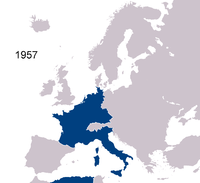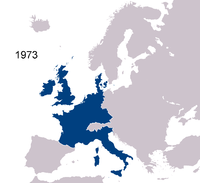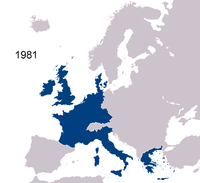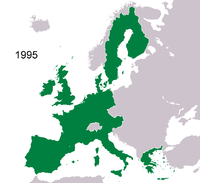
Statistics relating to enlargement of the European Union
Encyclopedia
the EU affiliated with the enlargement process.
|}
|}
This is a sequence of tables giving statistical data for past and future enlargements
Enlargement of the European Union
The Enlargement of the European Union is the process of expanding the European Union through the accession of new member states. This process began with the Inner Six, who founded the European Coal and Steel Community in 1952...
of the European Union
European Union
The European Union is an economic and political union of 27 independent member states which are located primarily in Europe. The EU traces its origins from the European Coal and Steel Community and the European Economic Community , formed by six countries in 1958...
. All data refer to the populations, land areas, and gross domestic product
Gross domestic product
Gross domestic product refers to the market value of all final goods and services produced within a country in a given period. GDP per capita is often considered an indicator of a country's standard of living....
s (GDP) of the respective countries at the time of their accession to the European Union, illustrating historically-accurate changes to the Union. The GDP figures are at purchasing power parity
Purchasing power parity
In economics, purchasing power parity is a condition between countries where an amount of money has the same purchasing power in different countries. The prices of the goods between the countries would only reflect the exchange rates...
, in United States dollar
United States dollar
The United States dollar , also referred to as the American dollar, is the official currency of the United States of America. It is divided into 100 smaller units called cents or pennies....
at 1990 prices.
Foundation

| Member countries | Population | Area (km²) | GDP (billion US$) |
GDP per capita (US$) |
|---|---|---|---|---|
| 9,052,707 | 30,528 | 58.316 | 6,442 | |
| 44,788,852 | 674,843 | 312.966 | 6,988 | |
| 54,292,038 | 248,717 | 400.554 | 7,378 | |
| 49,476,000 | 301,336 | 265.192 | 5,360 | |
| 310,291 | 2,586 | 2.938 | 9,469 | |
| 11,186,847 | 41,526 | 83.351 | 7,451 | |
| EC6 (1958) | 169,106,736 | 1,299,536 | 1,123.317 | 6,643 |
1973 enlargement

| Member countries | Population | Area (km²) | GDP (billion US$) |
GDP per capita (US$) |
|---|---|---|---|---|
| 5,021,861 | 43,094 | 70.032 | 13,945 | |
| 3,073,200 | 70,273 | 21.103 | 6,867 | |
| 56,210,000 | 244,820 | 675.941 | 12,025 | |
| Accession countries | 64,305,061 | 358,187 | 767.076 | 11,929 |
| Existing members (1973) | 192,457,106 | 1,299,536 | 2,381,396 | 12,374 |
| EC9 (1973) | 256,762,167 (+33.41%) |
1,657,723 (+25.44%) |
3,148.472 (+32.21%) |
12,262 (-0.91%) |

1981 enlargement
| Member countries | Population | Area (km²) | GDP (billion US$) |
GDP per capita (US$) |
|---|---|---|---|---|
| 9,729,350 | 131,945 | 86.553 | 8,896 | |
| Existing members (1981) | 261,743,191 | 1,657,723 | 3,694,558 | 14,115 |
| EC10 (1981) | 271,472,541 (+3.72%) |
1,789,668 (+7.96%) |
3,781.111 (+2.34%) |
13,928 (-1.33%) |

1986 enlargement
| Member countries | Population | Area (km²) | GDP (billion US$) |
GDP per capita (US$) |
|---|---|---|---|---|
| 9,907,411 | 92,391 | 85.610 | 8,641 | |
| 38,707,556 | 504,782 | 386.998 | 9,998 | |
| Accession countries | 48,614,967 | 597,173 | 472.608 | 9,721 |
| Existing members (1986) | 273,398,552 | 1,789,668 | 4,186.176 | 15,312 |
| EC12 (1986) EU12 (1993) |
366,867,431 (+17.53%) |
2,386,841 (+33.37%) |
4,658,784 (+11.29%) |
14,468 (-5.51%) |
1995 enlargement

| Member countries | Population | Area (km²) | GDP (billion US$) |
GDP per capita (US$) |
|---|---|---|---|---|
| 8,206,524 | 83,871 | 145.238 | 18,048 | |
| 5,261,008 | 338,145 | 80.955 | 15,859 | |
| 9,047,752 | 449,964 | 156.640 | 17,644 | |
| Accession countries | 22,029,977 | 871,980 | 382.833 | 17,378 |
| Existing members (1995) | 350,909,402 | 2,495,174 | 5,894.232 | 16,797 |
| EU15 (1995) | 372,939,379 (+6.28%) |
3,367,154 (+34.95%) |
6,277.065 (+6.50%) |
16,831 (+0.20%) |
2004 enlargement

| Member countries | Population | Area (km²) | GDP (billion US$) |
GDP per capita (US$) |
|---|---|---|---|---|
| 775,927 | 9,250 | 11.681 | 15,055 | |
| 10,246,178 | 78,866 | 105.248 | 10,272 | |
| 1,341,664 | 45,226 | 22.384 | 16,684 | |
| 10,032,375 | 93,030 | 102,183 | 10,100 | |
| 2,306,306 | 64,589 | 24.826 | 10,764 | |
| 3,607,899 | 65,200 | 31.971 | 8,861 | |
| 396,851 | 316 | 5.097 | 12,843 | |
| 38,580,445 | 311,904 | 316.438 | 8,202 | |
| 5,423,567 | 49,036 | 42.800 | 7,810 | |
| 2,011,473 | 20,273 | 29.633 | 23,900 | |
| Accession countries | 74,722,685 | 737,690 | 685.123 | 9,169 |
| Existing members (2004) | 381,781,620 | 3,367,154 | 7,711.871 | 20,200 |
| EU25 (2004) | 456,504,305 (+19.57%) |
4,104,844 (+17.97%) |
8,396,994 (+8.88%) |
18,394 (-8.94%) |
2007 enlargement

| Member countries | Population | Area (km²) | GDP (billion US$) |
GDP per capita (US$) |
|---|---|---|---|---|
| 7,761,000 | 111,002 | 62.29 | 8,026 | |
| 22,329,977 | 238,391 | 204.4 | 9,153 | |
| Accession countries | 30,090,977 | 349,393 | 266.69 | 8,863 |
| Existing members (2007) | 464,205,901 | 4,104,844 | 12,170.11 | 26,217 |
| EU27 (2007) | 494,296,878 (+6.48%) |
4,454,237 (+8.51%) |
12,436.80 (+2.04%) |
25,160.59 (-4.03%) |
Croatia
| Member countries | Population | Area (km²) | GDP (billion US$) |
GDP per capita (US$) |
|---|---|---|---|---|
| 4,486,881 | 56,594 | 62.457 | 17,675 | |
| EU28 (EU27 + Croatia) |
504,284,264 (+0.89%) |
4,381,376 (+1.30%) |
16,051.70 (+0.39%) |
30,374.96 (-0.45%) |
Iceland
| Member countries | Population | Area (km²) | GDP (billion US$) |
GDP per capita (US$) |
|---|---|---|---|---|
| 317,593 | 103,001 | 12.148 | 38,022 | |
| EU28 (EU27 + Iceland) |
501,577,433 (+0.06%) |
4,427,783 (+2.38%) |
14,793.12 (+0.01%) |
29,492.95 (-0.09%) |
Macedonia
| Member countries | Population | Area (km²) | GDP (billion US$) |
GDP per capita (US$) |
|---|---|---|---|---|
 Republic of Macedonia Macedonia , officially the Republic of Macedonia , is a country located in the central Balkan peninsula in Southeast Europe. It is one of the successor states of the former Yugoslavia, from which it declared independence in 1991... |
2,114,550 | 25,713 | 18.831 | 9,163 |
| EU28 (EU27 + Macedonia) |
501,909,405 (+0.42%) |
4,350,495 (+0.59%) |
15,265.83 (+0.12%) |
29,750.51 (-2.49%) |
Turkey
| Member countries | Population | Area (km²) | GDP (billion US$) |
GDP per capita (US$) |
|---|---|---|---|---|
| 74,816,000 | 783,562 | 915.212 | 13,138 | |
| EU28 (EU27 + Turkey) |
574,610,855 (+14.96%) |
5,108,344 (+18.11%) |
16,162.22 (+6.01%) |
29,892.46 (-2.03%) |
If these countries are added to the European Union, the total population of the EU would be aprox 581,214,814
Note: All data sourced from individual country entries on Wikipedia. Presumed source CIA World Factbook 2009. Populations usually 2009 estimates; historical/future estimates not used.
Footnotes
1. Algeria was part of France until 1962.2. German reunification in 1990 led to the inclusion of the territory of the former German Democratic Republic
German Democratic Republic
The German Democratic Republic , informally called East Germany by West Germany and other countries, was a socialist state established in 1949 in the Soviet zone of occupied Germany, including East Berlin of the Allied-occupied capital city...
. This enlargement is not explicitly mentioned. Data for Germany in all tables is from current statistics.
3. Greenland
Greenland
Greenland is an autonomous country within the Kingdom of Denmark, located between the Arctic and Atlantic Oceans, east of the Canadian Arctic Archipelago. Though physiographically a part of the continent of North America, Greenland has been politically and culturally associated with Europe for...
left the EC in 1985.
4. Officially the whole of Cyprus lies within the European Union. "In light of Protocol 10 of the Accession Treaty 2003 Cyprus as a whole entered the EU, whereas the acquis is suspended in the northern part of the island (“areas not under effective control of the Government of the Republic of Cyprus”). This means inter alia that these areas are outside the customs and fiscal territory of the EU. The suspension has territorial effect, but does not concern the personal rights of Turkish Cypriots as EU citizens, as they are considered as citizens of the Member State Republic of Cyprus"http://ec.europa.eu/enlargement/turkish_cypriot_community/index_en.htm.

